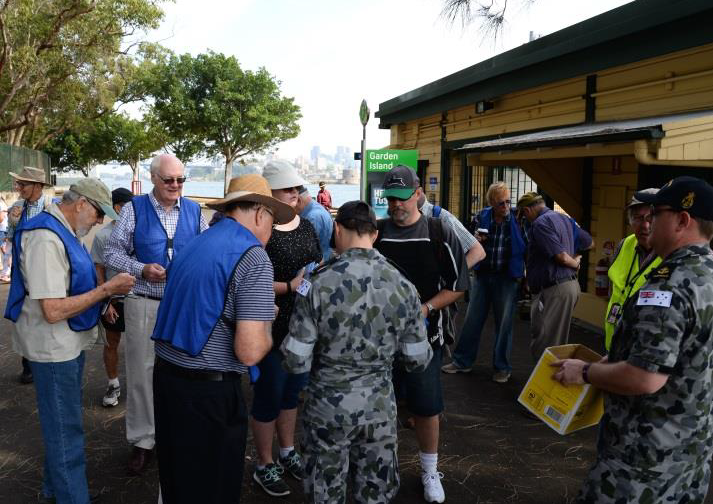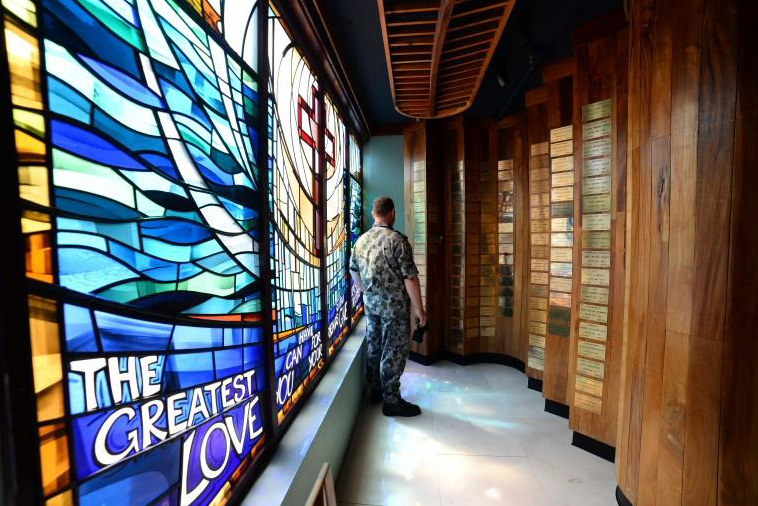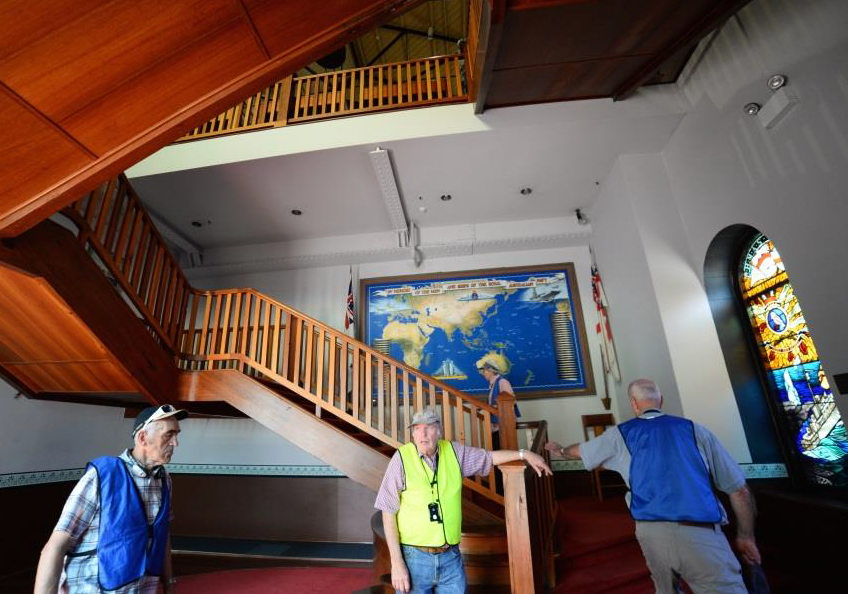The Shed Trip to Garden Island
- 2017-11-27
- By Hornsby Mens Shed
- Posted in Member's Outings
Thanks to Ian Raper, 15 members plus guests had a unique experience during the outing Garden Island, both a naval base and public picnic grounds in Sydney Harbour. We met at Pier 2, Circular Quay, to catch the 10.05am Watsons Bay ferry for the short ride to the island (it is not strictly an island since land was re-claimed in the 1940s, effectively joining it to Potts Point).
A Brief History of Garden Island
The Navy relationship with Garden Island began 10 days after the Fleet arrived in 1788 when Captain Phillip gave it to the crew of the SIRIUS to grow their vegetables. It was referred to then as “The Garden Island”. The stewardship of the Navy has been interrupted from time to time, however the Commonwealth Government owns Garden Island and it is a Naval establishment controlled by the Commanding Officer HMAS KUTTABUL. ADI and some other non-Navy units lodge on parts of the Garden Island site.

Garden Island has a rich and active history. The key phases in its history are:
-
- Pre 1788: Australian Aboriginal use of Garden Island
- 1788: European settlement and use of Garden Island as a naval port and ship repair site
- 1940-1946: World War II and the building of the Captain Cook Graving Dock
- 1946-1990: Garden Island as the nations dedicated strategic naval defence site
- 2002: Garden Island now
 We were welcomed at the ferry wharf by a guide and two uniformed sailors who asked for photo IDs and handed out blue vests for us to wear. He gave us some information about the base then led us through the public area to the Royal Australian Navy Heritage Centre that was full of interesting naval artifacts, sailors in their smart uniforms, the museum and the Salthorse Café where we would be having lunch at the end of the tour.
We were welcomed at the ferry wharf by a guide and two uniformed sailors who asked for photo IDs and handed out blue vests for us to wear. He gave us some information about the base then led us through the public area to the Royal Australian Navy Heritage Centre that was full of interesting naval artifacts, sailors in their smart uniforms, the museum and the Salthorse Café where we would be having lunch at the end of the tour.
We then proceeded down the road to the secured area, past some huge gun barrels, parts of the old cranes, ship memorials and missile launchers. Passing through the security gates, we entered the Boatshed where we watched an interesting video on the history of the island. Three guides were provided so we split into groups, each also accompanied by a sailor.
Chapel of Remembrance
All timbers used in the Chapel of Remembrance are either reclaimed or recycled and are generally over one hundred years in age. Wall panelling was milled from a rare reclaimed log
of Australian cedar found in Bowral. The pillars or ‘masts’ are carved from reclaimed rosewood logs found in Mullumbimby. Ceiling timbers consist of recycled Oregon laminated beams and
recycled kauri ribs from the Grace Bros site in Broadway. The altar stone is topped with carved and shaped red ironbark floor joists from the site. The top of the reception table located in the
vestibule is also made from the same red ironbark together with Tasmanian oak stair treads recycled from the removed spiral stair. The base of the reception table is made up from various recycled hardwoods. Chairs with leather seats are made from a combination of recycled blackbutt, Australian red cedar, western red cedar and maple.


The adaptation of the stair to an imposing ‘floating’ structure has ensured that massive red and grey ironbark bearers reclaimed from the RTA site in Botany will remain part of our history. The bearers, 5.5 metres in length x 450mm x 350mm in section were sent to Echuca on the Victorian border, the only known place with the facility to mill timber of this size. Ironbark is used for all stringers and balustrade posts. The main stringer is red ironbark and located directly above the main entry doors, is 3.2 metres in length and twice cranked x 450mm x 150mm in section and weighs approximately 1.3 tonnes. Taking a good part of the overall live and dead load, this stringer is fixed into the walls at either end giving the appearance of a ‘floating’ stair. Sydney blue gum, reclaimed from the Home Yardage Building, formerly WD & HO Wills warehouse in Kent and Bathurst Streets Sydney, will also remain a part of our history. The reclaimed timber is 350mm x 75mm sections of floor joists and is used for the risers, treads, landings, handrails and balustrades.
Tunnel System
There is a tunnel system under Garden Island that was once used by the Royal Australian Navy. Within this tunnel system was a power station, offices and air raid shelters. This tunnel complex also had a command centre. Other tunnels also exist which headed further in towards Kings Cross. The tunnels were used to move guns from one side of the island to the other.
After the tour, we had lunch at the Salthorse Café which had an interesting display of naval items. The Café is housed in the Royal Australian Navy Heritage Centre building. There was time to explore before our ferry was due to arrive so some of us climbed the stairs to the top of the Centre which led to the highest point of the island and some magnificent views to the mainland and parts of the naval base, using a long lens.

Categories
- Charities
- Furniture/Cabinet Making
- General
- Member's Outings
- Member's Stories
- Safety
- Shed Promotion
- Uncategorised
- Wood Carving
- Woodturning
- Woodworking
Opening Days and Hours
Monday: 9.00am to 2.00pm
Tuesday: 9.00am to 2.00pm
Wednesday: 9.00am to 2.00pm
Friday: 9.00am to 2.00pm
Saturday: 9.00am to 3.00pm
Woodturning and woodcarving ONLY
Thursday: 9.00am to 2.00pm
Members’ meeting: 3rd Friday of each month from 12pm to 2pm.
Woodturners’ Meeting: 2nd Saturday of each month from 10am to 3pm (February – November)


Terrific imposing ‘floating’ structure. Would love something like this in my place ha ha. I wish. Looks like a great day was had by all.